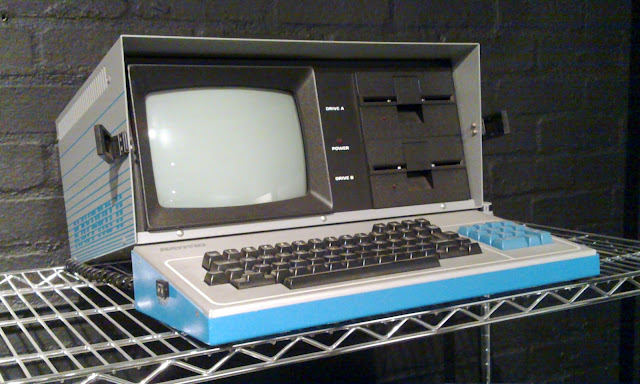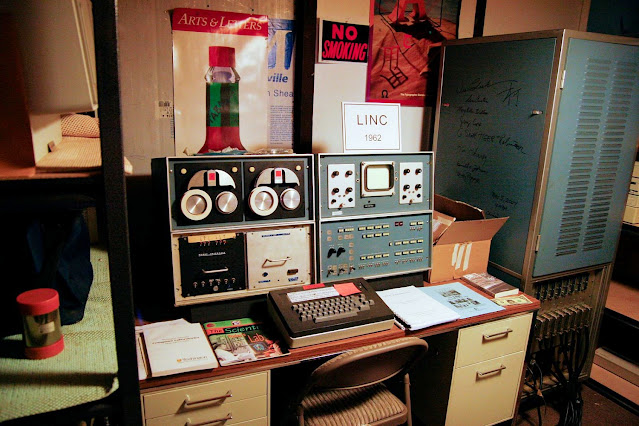Introduced March 1982
A few years after the introduction of the first generation of practical microcomputers, manufacturers started to look at the possibility of having a computer that you could take anywhere rather than have tied to a desk. Perhaps the best known of this first generation of “luggable” microcomputers was the Osborne 1, launched in 1981.
The Osborne had plenty of limitations, not least the tiny screen. The market was ready for something better, and something better certainly turned up with the Kaypro II. It was designed by a company called (at the time) Non-Linear Systems (or just “NLS”), who up until this point had made lab equipment. NLS knew how to make reliable, rugged and portable electronics and they turned this expertise to a microcomputer.
 |
| A Kaypro II with several other vintage portables |
Running the de-facto standard CP/M operating system and running on a 2.5MHz Z80 CPU with 64Kb of RAM and dual floppy disks, the Kaypro II had highly competitive specs for the era. Built into the high-quality painted aluminium case was a pin sharp 9 inch display which you could comfortably use all the time. The keyboard was also a high-quality design and it clipped firmly into place on the case making a practical if somewhat hefty 13 kilogram computer.
It wasn’t just the hardware that made the computer competitive. The Kaypro II was bundled with an office suite from Perfect Software that included a wordprocessor, spreadsheet and database, plus a version of BASIC that could be compiled into CP/M .com programs. Eventually the bundled programs included the class-leading WordStar wordprocessor and SuperCalc spreadsheet. The bundled software theoretically cost many hundreds of dollars, making the Kaypro II seem more of a bargain. If what you wanted wasn't in the box, then there was a wide range of business and home software available, including the legendary
Zork.
 |
| Please give this Kaypro II a home |
This was a high-quality, reliable, well-designed and inexpensive product and it became quite a success. If you took one home from the store there really wasn’t much you needed to do except plug a few cables in. Everything else was in the box, making this an extremely consumer friendly-product.
It ended up as a popular tool with writers.
Arthur C Clarke had one, as did
Jerry Pournelle. Although it was always a bit of a niche system, the Kaypro II was enough of a success to make NLS a major player in the early 1980s market.
Curiously, there was never a Kaypro I as such. Aping the rival Apple II, NLS decided on making their first commercial machine another “II”. In 1983 it was followed by the improved
Kaypro IV and
Kaypro 10 (with a 10Mb hard disk), then in 1984 followed the
Kaypro 4 and
Kaypro 2X which were confusingly named, and if you thought
that was confusing another
Kaypro 2 followed in 1985 and the
Kaypro 1 in 1986 (because why the heck not call it the “1”). All those Kaypro machines ran CP/M, it took until 1985 for Kaypro (as it changed its name to) to come up with a PC-compatible system with the
Kaypro PC and the
Kaypro 286i, which was the world’s first AT-compatible system. Kaypro also adapted their luggable boxes with the MS-DOS capable
Kaypro 4 Plus 88 and
Kaypro 16. Kaypro even managed an early MS-DOS laptop with the slightly peculiar
Kaypro 2000 and the qurkly and deeply unreliable CP/M
Kaypro Robie. Somewhere along the line NLS changed its name to “Kaypro” as well.
Kaypro went from boom to bust quite quickly. The II was launched after the
IBM PC but before it became really popular. It took four years for Kaypro to come up with their own PC, by which time the rapidly-evolving market had moved on. Despite soldiering on for a few years, Kaypro went bankrupt in 1992.
As with almost all microcomputer companies of the era, the success of Kaypro was relatively short-lived. However, they were the first company to come up with a practical and affordable portable computer, furthermore one that required very little work to get it fully operational, with a high-quality build and smart looks. The Kaypro II undoubtedly influence other computer designs of the same and next generation.
Today the Kaypro CP/M portables are somewhat collectable, although many have become separated from the floppy disks that held the software. Most available systems are in the US but some can be found in Europe, but expect to pay several hundred pounds
Image credits:
Diaper via Flickr - CC BY 2.0
Daniel Boulet via Flickr - CC BY-NC 2.0






